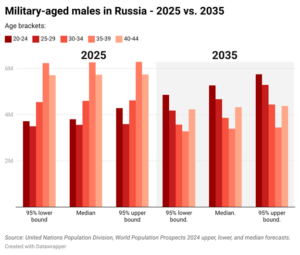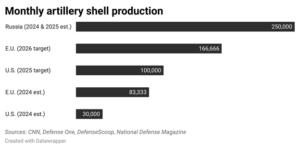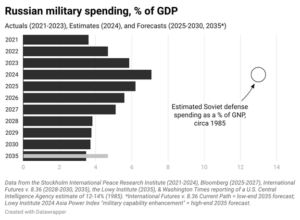Russian forces in Ukraine are suffering casualties at more than 400,000 per year — enough to pack the house at the world’s four largest stadiums. Losses like these have been fuel for simultaneous talk of inevitable Russian defeat or victory in the public conversation.
What should we make of this talk? Can Russian forces sustain similar losses in its ongoing war in Ukraine and rebuild to fight another day? The likely answer is “yes,” and it speaks to Russian President Vladimir Putin’s approach toward negotiations to end the war. In refusing to agree to an unconditional ceasefire and skipping the latest peace talks in Turkey, Putin is playing for time — because time appears to be on his side.
While Russia could run out of quality recruits, force replenishment through 2024 was far more successful than many predicted. In April of that year, NATO Supreme Allied Commander in Europe Gen. Christopher Cavoli observed that “Russia is reconstituting that force far faster than our initial estimates suggested. The army is actually now larger — by 15 percent — than it was when it invaded Ukraine.” Whether Russia can maintain its ability to reconstitute and even grow its forces as its war in Ukraine progresses remains uncertain. More certain is its advantage over Ukraine in terms of total population, with nearly four times as many people and roughly 18.9 million males aged 20–39 relative to Ukraine’s fewer than five million males of that age. Russia can lose three times as many troops as Ukraine and still suffer less in relative terms.
By 2035, Russia will have roughly 1.22 to 3.58 million fewer military-aged males than in 2025, according to U.N. Population Division forecasts. However, even their 95 percent lower bound forecast for 2035 leaves a total population of Russian males between the ages of 20 and 44 of 20.1 million — a number that is greater than half of Ukraine’s total population as of 2023.

In terms of replenishment of equipment, Russia also largely holds the upper hand over Ukraine. Artillery shells have proven particularly crucial in the attritional, positional fighting that has characterized much of the fighting after the early months following Russia’s February 2022 invasion. In March 2024, one European intelligence official estimated that 12,000 artillery shells were being fired in Ukraine each day — roughly 10,000 by Russian forces and 2,000 by Ukrainian forces. This gap has led to a “significant advantage on the battlefield,” and one that may be growing.
In 2024, Russian industry was producing roughly 250,000 new artillery shells each month, a pace expected to continue through 2025. This is compared to an estimated 30,000 produced by the United States each month in 2024 and another roughly 83,000 produced by E.U. member countries aiding Ukraine. Assuming Russian production rates hold constant, only by 2026 will the combined U.S. and E.U. monthly artillery shell production pass Russia, if we also assume that U.S. and E.U. targets are met. Moreover, for this to matter for Ukraine, the United States needs to continue to supply Ukraine — a questionable assumption given U.S. President Donald Trump’s stated desire to shift the burden of support for Ukraine to America’s European allies.

Russia has been relying heavily on Soviet-era stocks for medium and heavy equipment replenishment. Indeed, its stock of Soviet-era tanks are far from tapped and could be further relied upon if needed. But it is not as if the majority of Russian tanks on the battlefield have been older models pulled from storage and refurbished — Russia’s new production has been noteworthy. The U.K. Ministry of Defence assessed as of January 2024 that Russia had the ability to “produce 100 main battle tanks per month” and could likely maintain offensive armor operations for the “foreseeable future.” Testimony from Cavoli on April 3, 2025, further increased that estimate, stating that Russia is expected to produce “1,500 tanks and 3,000 armored vehicles” in 2025.
The Russian defense industry may not be able to further increase its already ramped-up T-90 tank production, for example, but it may not need to. Even if losses continue apace, some analysts assert that Russia can maintain its recent rate of losses through 2026 or 2027. This reality is apparently well appreciated by Ukrainians on the battlefield. Indicative of this is one commander in Ukraine’s 11th National Guard Brigade’s exasperated statement after fighting near Kherson in January 2024: “No matter how many times we hit the same places, [the Russians] are constantly replenished.”

In the long term, there is a question of the sustainability of Russia’s military Keynesianism. If the Kremlin spends as planned for 2025, 40 percent of Russia’s federal expenditures would go to defense and national security — a share that would exceed Russia’s combined spending on education, health, and social and economic welfare. In contrast, to maintain its global force posture, defense spending in the United States has averaged 15 percent of the total U.S. government budget over the past decade.
Such a high rate of defense and national security spending will have a toll on non-military priorities in Russia. In the classic guns-and-butter logic made famous in a 1953 speech from President Dwight Eisenhower, money spent on military operations is also money not spent on health, education, and other domestic priorities. These tradeoffs arguably led to the collapse of the Soviet Union — or at least this was part of the logic that motivated U.S. strategic competition in the Cold War with the Soviets. However, Russia’s estimated military spending levels as a percent of GDP are nowhere near estimated Soviet levels of the mid-1980s, when societal strains were reaching their peak.

Russia’s economy has and will continue to face strains. Amid these strains, we can expect some analysts to continue to make dire predictions, arguing that Russian economic collapse is imminent. It is also plausible that Russia’s economy will continue to muddle through, with faster economic growth than much of Western Europe over the next few years. If so, the Russian military menace is unlikely to disappear any time soon. As Chatham House’s Mathieu Boulègue contends, “the Russian military industry remains a formidable machine. It is likely to continue to be able to muddle along, producing ‘good enough’ systems that will still represent a significant threat to Ukraine, NATO and their allies. This is especially true for stand-off and asymmetric capabilities that have not yet been engaged in the war against Ukraine.”
Collin Meisel is director of analysis at the Frederick S. Pardee Institute for International Futures in the University of Denver’s Josef Korbel School of International Studies.
Mathew Burrows serves as counselor in the Executive Office at the Stimson Center and is co-author of the recent book, World to Come: Return of Trump and End of the Old Order.
Image: The Kremlin via Wikimedia Commons

